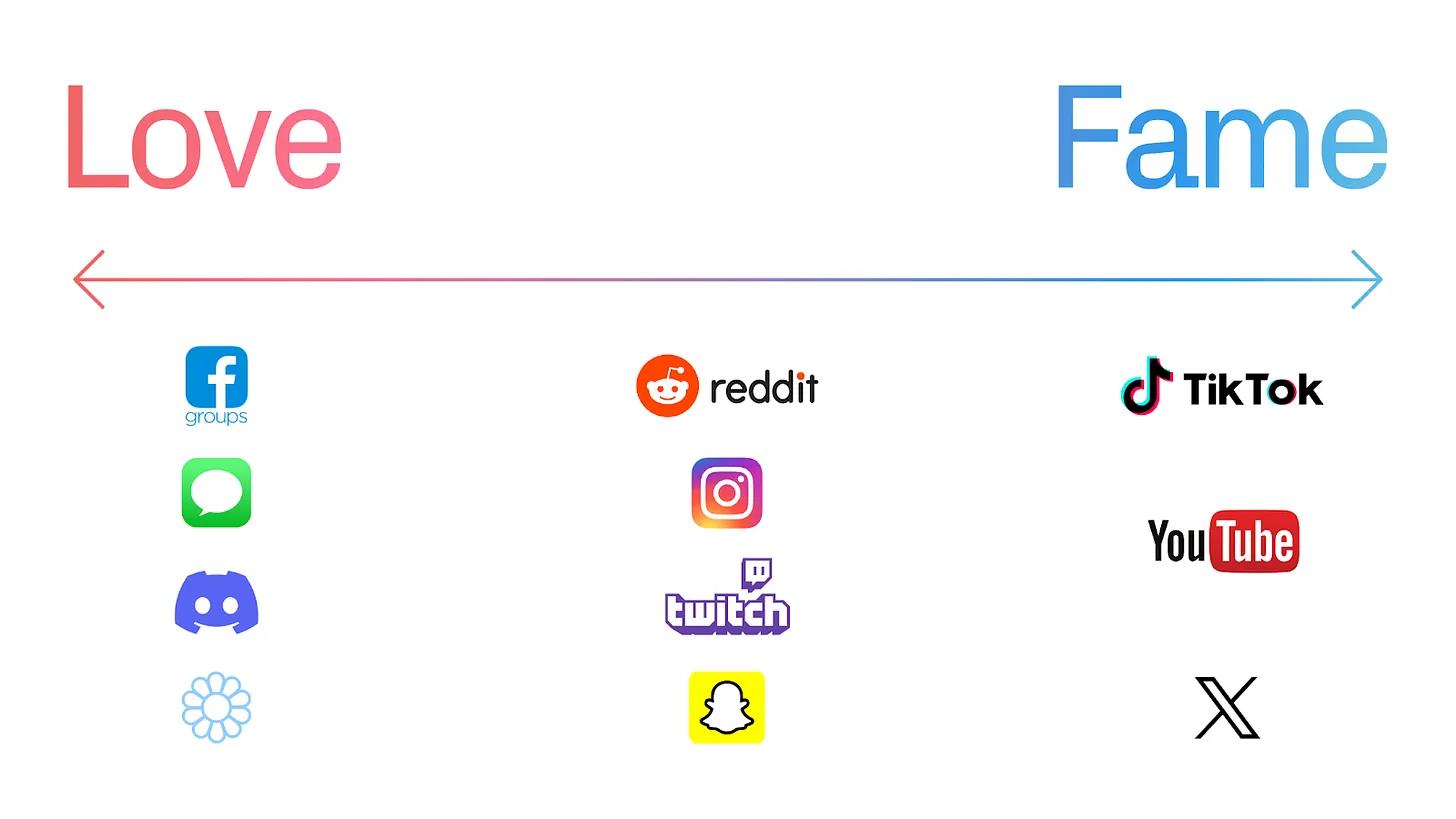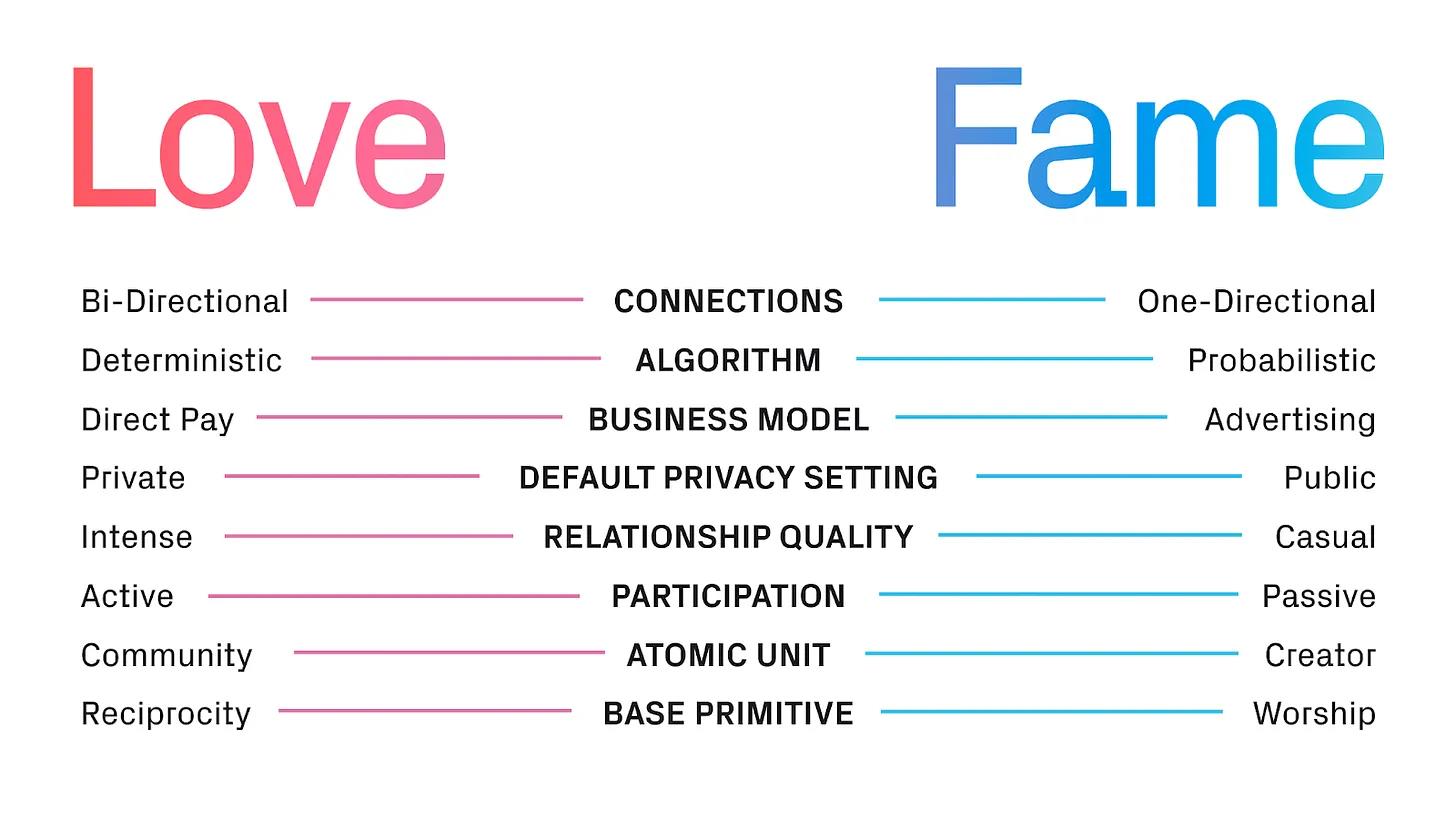Written by: Li Jin
Translated by: TechFlow

While "social" is often generalized as a single category, today's social applications actually have many differences.
One aspect I like to analyze about social networks is the role they play—how much do users desire love and reputation.
Years ago, Twitch co-founder Kevin Lin told me that Twitch provides creators with value across three dimensions: love, reputation, and money. For the purpose of this article, I'll set money— or the potential for income— aside, as it's an orthogonal dimension that I'll explain in detail later.
All social apps fall within the spectrum of love to reputation
In terms of love, some products focus on deepening connections with others. Examples include iMessage, WhatsApp, early Facebook, and Discord. Their value proposition is to consciously connect with others, nurture existing relationships, and enhance intimacy. These products typically feature bidirectional relationships, such as friends on Facebook or iMessage. When users engage with products like Discord or WhatsApp, it's often for a specific community or individual, rather than for discovering new content. These products reinforce this value proposition by adopting deterministic algorithms (if A sends certain content to B, the other person will always receive it).
In terms of reputation, some products help users gain fame or influence. These products are built around the discovery of new content and creators. Examples of reputation-centric social products include YouTube, Instagram, TikTok, and Twitch. These products feature unidirectional relationships (or "followers"). Influential users professionalize, become creators, and reach increasingly larger audiences, a dynamic that doesn't exist in bidirectional social networks. These products use probabilistic algorithms to display content based on the likelihood of engagement, so they can't guarantee that users will reach their followers.
These two extremes can be summarized as social networking versus social media.
There's an inherent tension in building products for love and reputation, rooted in the zero-sum nature of time and attention: users have limited time to spend on any social app, so an app that emphasizes discovering new content from creators rather than interacting with existing contacts is inherently more oriented toward reputation than love.
An example here is TikTok's default "For You" page: it underweights the follower graph and defaults to showing users new creators and recommended content.
The love-reputation dichotomy is a spectrum; platforms often have elements that cater to both love and reputation simultaneously. Instagram—trending more toward reputation over time—has both reputation features (Explore, Reels) and love features (DMs, Stories, Close Friends). Reddit's homepage can be browsed as a reputation product, showcasing content from across Reddit, but when users use the platform to browse specific subreddits, there's intimacy among community members, making it a love product. The blend of both types of features creates higher retention, as there isn't enough compelling love content. WhatsApp, Messenger, and iMessage have remained pure love tools due to their network effects, but other social apps have had to add reputation features to improve retention.
The broad trend of social products tilting toward "reputation"
I often hear people say that they feel, at a broader level, social networks are evolving into social media; apps that were once focused on friends are now focused on entertainment, and everyone is now expected to be a creator. Instagram, once used to follow friends' lives, is now mostly used to follow creators and brands.
I think this makes sense, and it's driven by the business model and incentives rooted in network effects. Social networks with bidirectional social graphs hit a ceiling once users reach the limit of people they know. Products like iMessage or early Facebook don't scale in utility with the total user base. Instead, they hit a ceiling once users have connected with all their friends. However, reputation-based products have more unlimited network effects: users can see content from anyone, and as more users join, the utility keeps increasing. In an ad-driven business model, the primary goal is to get more users to engage for longer, and a reputation-driven model is better for expanding user attention and revenue.
Interestingly, social products related to love often struggle to monetize well through advertising: users don't want ads inserted into messages to friends or smaller communities, which is understandable. Instead, the dominant business model for love-based products tends to be subscription-based, whether for the platform (e.g., Discord Nitro, or WhatsApp's initial $1/year fee) or for specific creators or communities (Twitch subscriptions). This is even more pronounced in dating apps, where the prices for subscribing to Hinge, Bumble, and Tinder are even higher. People are willing to pay more for more serious relationships and connections.
Successful reputation platforms also have a skill-based status game at their core, as described by Eugene Wei in his article about status as a service. In contrast, that kind of status game is less prominent in love-based products, limited to smaller networks. Most love-based social products are more like feature-rich communication tools rather than platforms for seeking social status. They provide utility in users' lives by connecting them with friends or groups, rather than being a stage for performance. Of course, some products introduce the status game into love platforms—imagine the upvotes/downvotes on Reddit posts—but the status game is generally less pronounced.
Many users have pointed out that the shift in the meaningful atmosphere on X (formerly known as Twitter) indicates a transition from a love-themed platform to a reputation-centric platform. While the previous default news feed prioritized tweets from accounts you follow, the new algorithm is filled with tweets from people you don't know. The new default "For You" page shows algorithmically determined posts that you might like based on engagement likelihood. Analysis of its open algorithm also revealed that subscribers to X Premium (formerly Twitter Blue) are given a boost in their feed ranking. This design de-emphasizes the follower graph that users curate over time, instead adopting a more engagement-driven and recommendation-based model, significantly changing the platform's tone; it shifts it from a carefully curated mix of creators to a more viral, popularity-driven platform.
As we've seen in mature social networks, the trend toward reputation creates opportunities for new networks focused on deepening connections. Love-based products have space to serve smaller communities and groups, especially as existing incumbents reliant on ad-based business models seek ever-increasing user attention to grow their businesses.
Newer social media apps often focus on an initial use case targeting a smaller group. Apps like BeReal, Retro, and Lapse each offer their own perspective on facilitating deeper connections with friends, while reputation-based social media overlooks this (to varying degrees of success). However, apps focused on smaller use cases often struggle with profitability and may become victims of their own success, as their growth and novelty erode the value proposition of deep connections with smaller groups.

Encrypted Social: A New Business Model for Love and Reputation
So far, encrypted social networking has been mainly about love (helping users form and monetize deeper connections) rather than reputation. Compared to Web2, where ad-based business models put pressure on social media and entertainment products, encryption enables love-based networks to uniquely thrive and survive.I've written before:
Encrypted social networks can enable new business models that make the existence and flourishing of smaller, high-context communities possible. Today, the most important goal for most web2 social platforms is relentless growth, consistent with their ad-based business models. This means that products focused on smaller groups, such as Facebook Groups or Twitter Communities, or the now-defunct Path, don't have good business models.
Encryption can change this by making it possible for these smaller communities to exist and thrive. This can take the form of: shared finances (Nouns DAO or FWB), and creating consistency for maintaining community health, or minting on-chain artifacts of the community as a way to generate income (e.g., Crypto, Culture & Society DAO, a learning community).
A few years ago, Facebook experimented with a feature that allowed group admins to charge entry/membership fees to support the costs of managing and maintaining their communities (for many, this is a full-time job). For some reason, this feature was discontinued, and FB Groups still haven't found good monetization. I believe users are willing to pay to support smaller, healthier communities, but the infrastructure to achieve this is lacking. With encryption, these communities can more easily choose and configure their own business models, and with that, we can see the flourishing of smaller communities.
Narrowing the focus, the biggest successes in the social space have historically come from the creation of new networks: from real-life friend-based networks (Facebook) to interest-based (Reddit, TikTok) to knowledge-based (Quora). Encryption has the opportunity to attempt to build a new type of ownership-based network, leveraging on-chain assets as the foundation for new communities. We call this idea a social-economic network (as opposed to purely social networks).
These communities can deepen connections among users and help them find their tribes through shared ownership. In the real world, shared ownership is often the basis for connections, from neighbors to colleagues at a startup.DAO and NFT are early examples of high-affinity communities based on shared ownership on the chain. In October 2023 alone, over 17 million NFTs were minted on Ethereum and L2; with increasing user activity, one can imagine inferring user interests based on on-chain behavior and showcasing connections based on rich activity history.
Reputation and influence are a tricky value proposition in cryptocurrency, as there are only about 400,000 active wallets on Ethereum daily. However, this number is steadily growing and is now large enough to build a discovery-focused platform, especially those monetizing through non-advertising models. To build a sticky social product focused on reputation, the key is to leverage user psychology and the desire for social status. This means introducing a new skill-based game.
Skill-based games in the crypto space often focus on aspects related to income, spending, or other financial aspects. For example, the leaderboard on Friend.tech can be seen as a status game, where rankings are determined based on the highest key price, i.e., the number of holders. I believe money-based status games are inherently exclusive, favoring those with more capital and being intimidating to newcomers. For example, a new TikTok user might feel they can win the app's core status game, creative videos, but a newcomer to a financialized social network might feel at a disadvantage.
Crypto can offer a new, low-barrier status game, namely "proof of early": who did something first, discovered who, or minted something first, all based on on-chain activity.
An example of this is Sound.xyz's "Earliest" view, which showcases the earliest supported artists. This behavior has precedent in Web2, where users like to comment "first" or "early" on some content, indicating that they were the first to discover it. On a crypto social app, user behavior is timestamped on-chain, and such "proof of early" can not only be generated by users but also presented in a more automated way, designed around gamified mechanisms.
As mature social networks lean more towards reputation, new networks have space to focus on deepening connections between communities. The unique features of cryptocurrency create opportunities for the flourishing of the entire spectrum of love and reputation, connecting users based on shared ownership and interests. I believe new business models will emerge to support different and smaller networks, rather than relying solely on ad-based models, to meet human needs for social status and connections in novel ways. 免责声明:本文章仅代表作者个人观点,不代表本平台的立场和观点。本文章仅供信息分享,不构成对任何人的任何投资建议。用户与作者之间的任何争议,与本平台无关。如网页中刊载的文章或图片涉及侵权,请提供相关的权利证明和身份证明发送邮件到support@aicoin.com,本平台相关工作人员将会进行核查。




